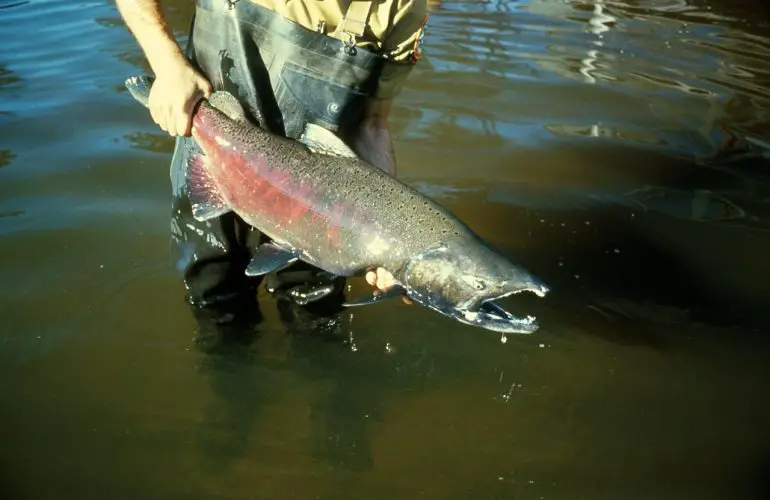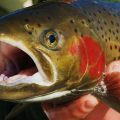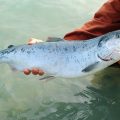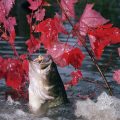King salmon is also known as chinook salmon and it is considered the biggest and best
salmon species. As the name implies, king salmon is a grand salmon fish primarily
found along the Pacific waters near Alaska, Canada and the Northwestern part of
the United States. People love to eat this salmon and it’s also very profitable
for the fishing industry overall. The material presented here will provide you
with king salmon information that will describe what they are and why they are
so important to certain economies, ecosystems and people’s dinner plates.
Basic Information about the King Salmon
The king salmon gets its name from its immense size. The ocean dwelling fish is also
known as the chinook. This name is derived from the Chinookan people that
reside along the coastal areas of the Pacific Northwest. Throughout their long
existence the different Chinookan groups would fish this oversized water fish
for food and sport. The king salmon is also known as the Quinnat Salmon, Tyee
salmon, chrome hog and the spring salmon.
This species of salmon is known as genus Oncorhynchus. There are 5 other types of salmon
which are classified under this scientific heading. They include coho, chum,
sockeye, and pink. King Salmon has so many names because it is a highly prized
source of food for many people that reside within the Pacific Northwest and in
other parts of the world where this variety of salmon is consumed.
What does the king salmon look like?
This
saltwater fish has a black irregular spotting on its back. It also has black
spots on its fins and its lobes. King salmon even has black pigment on its
gumline. Some people even refer to it as the “blackmouth” in some areas. Some
types of king salmon can have blue-green color combination. This part of their
body fades into a grayish and/or white hue. The gray color becomes more defined
as the chinook matures.
Male salmon typically have a red coloration, but this hue is not very dominate. It slight
enough where you really wouldn’t notice it unless you are looking at very
closely. Males also have a ridgeback and a hooked nose with an upper jaw. The
females have torpedo shaped body and they have blunt noses. Their midsections
are very hearty. The young salmon are known as fry and they have parr marks on
their body and lateral lines. Salmon that are traveling to the ocean are
usually noticeable by parr marks and lateral lines being on their body. Silvery
streaks with dark purple or black mouths can also be distinguishing mark as well.
The size of the king salmon ranges anywhere from 3 to 5 feet. They can also weigh up to 126
pounds. This is about as big as a normal sized teenager. The average chinook
weighs about 3 – 5 pounds which is a lot for a fish. They are a hearty sized
fish species, and this is where their name is derived.
Where does the king salmon live?
The king salmon lives in fresh-water streams and in estuaries. Some even live in the
ocean as well. However, this species of salmon will mostly be found in the
fresh-water streams and estuaries because it provides them the best environment
for spawning new fry. The chinook can be found in Northern California, along
the coastal areas of Washington and Oregon states.
They are also found along the coastlines of Canada’s provinces such as the Yukon
Territory and British Colombia. They can also be in and around the area of the
Chukchi Sea in Alaska. This species of fish can even be found near Asia in
places such as the coastlines of Siberia and Japan. Many of the animals have
their spawning runs in these areas or they will perform this activity out in
the ocean areas.
Salmon farms are also known to raise these fish as well. They have been introduced (through
human intervention) into areas of New Zealand and in the Great Lakes area.
Fresh water is typically needed for the king salmon to spawn. So, the fish are
constantly searching for fresh and clean water to produce the best outcome.
Estuaries make the best spawning sites. However, salmon don’t just use
estuaries to spawn.
King Salmon Eating Habits
When a king salmon is a fry or juvenile, they will mainly consume plankton and insects. As
they mature the fish will consume organisms such as herring, pilchard,
sandlance, crustaceans and squid. The creatures will eventually gain more
weight as they eat bigger species of fish and other sea creatures. They will
double their weight over the course of a summer. Some species will continue
this process until they die. This is why king salmon have such a huge size.
Mating Habits
King salmon reproduce through the process of spawning. When animals spawn the female will
deposit her eggs and the male will then come along and release sperm on them. A
female can lay between 3,000 and 14,000 eggs. This process usually happens with
fish. Chinook become sexually mature by the time the reach their 2nd year of
life. The spawning process happens every year until they pass.
Life Cycle of the King Salmon
The king salmon usually lives up to 7 years if they are not consumed for commercial use.
During their short life spans they make it a point to reproduce. That is the
key activity of the king salmon’s life. They spend their lives traveling from
one breeding ground to the next and consuming other animals along the way. The
life of a king salmon is not that exciting, but these sea fishes do travel for
thousands of miles to different locations and in a sense, they see more of the world than most people
do.
King Salmon Predators
King salmon has plenty of predators which include the osprey, sharks, bears, otters, eagles
and humans. By far, humans are the biggest predators of the king salmon. Many
people in Northwestern America and in other parts of the United States enjoy
consuming the king salmon. While the salmon lays a ton of eggs, many of these
eggs do not survive. Still, more than enough salmon mature into fully mature
fish. They are then consumed by different species and they are extremely
important to the food chain of humans and animals that feed on them.
The King Salmon as an Endangered Species
While there are plenty of king salmon available in the world, the species is slowly
declining in population. This decline is due to commercial consumption of this
fish. It has been estimated that at least 40% of its population has been lost.
Many people enjoy eating chinook and its popularity is one reason why it is
quickly diminishing. Still, conservation efforts are helping to keep the
chinook around and populations strong. Farming areas for the chinook are being
established in other parts of the world. These farming areas will help the fish
population to rebound. Also, many states and countries have laws about
procuring process for this type of fish.
Ultimately, the king salmon is a popular fish that many people enjoy eating at restaurants
and home. They are an important food source for animals as well. The king
salmon is a huge species that is important to many people and animal’s diet.
The fish is very respected by the cultures and companies that consume them and
use them for business.













Pingback: Salmon recipes in the oven | Reel Fishing Guru